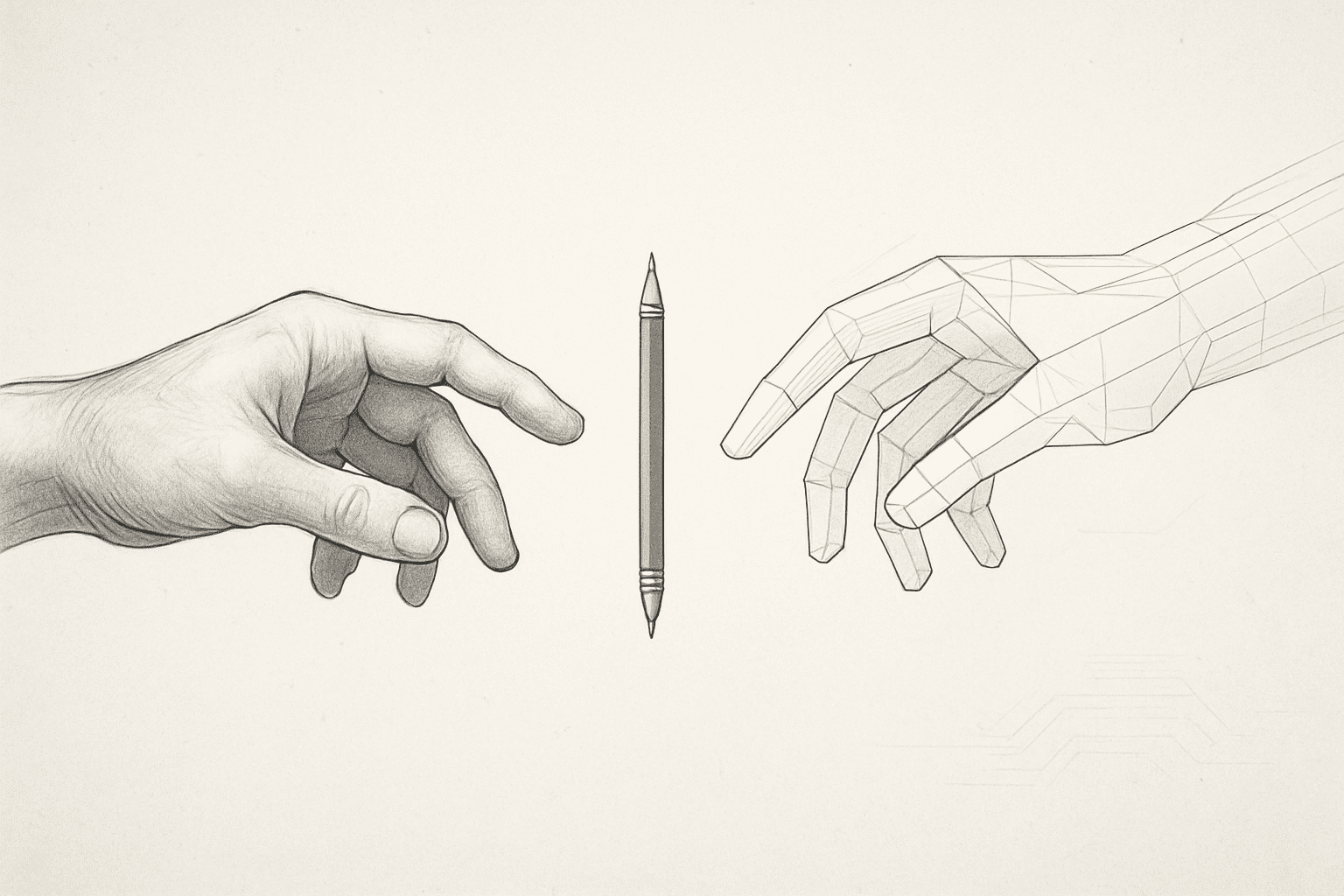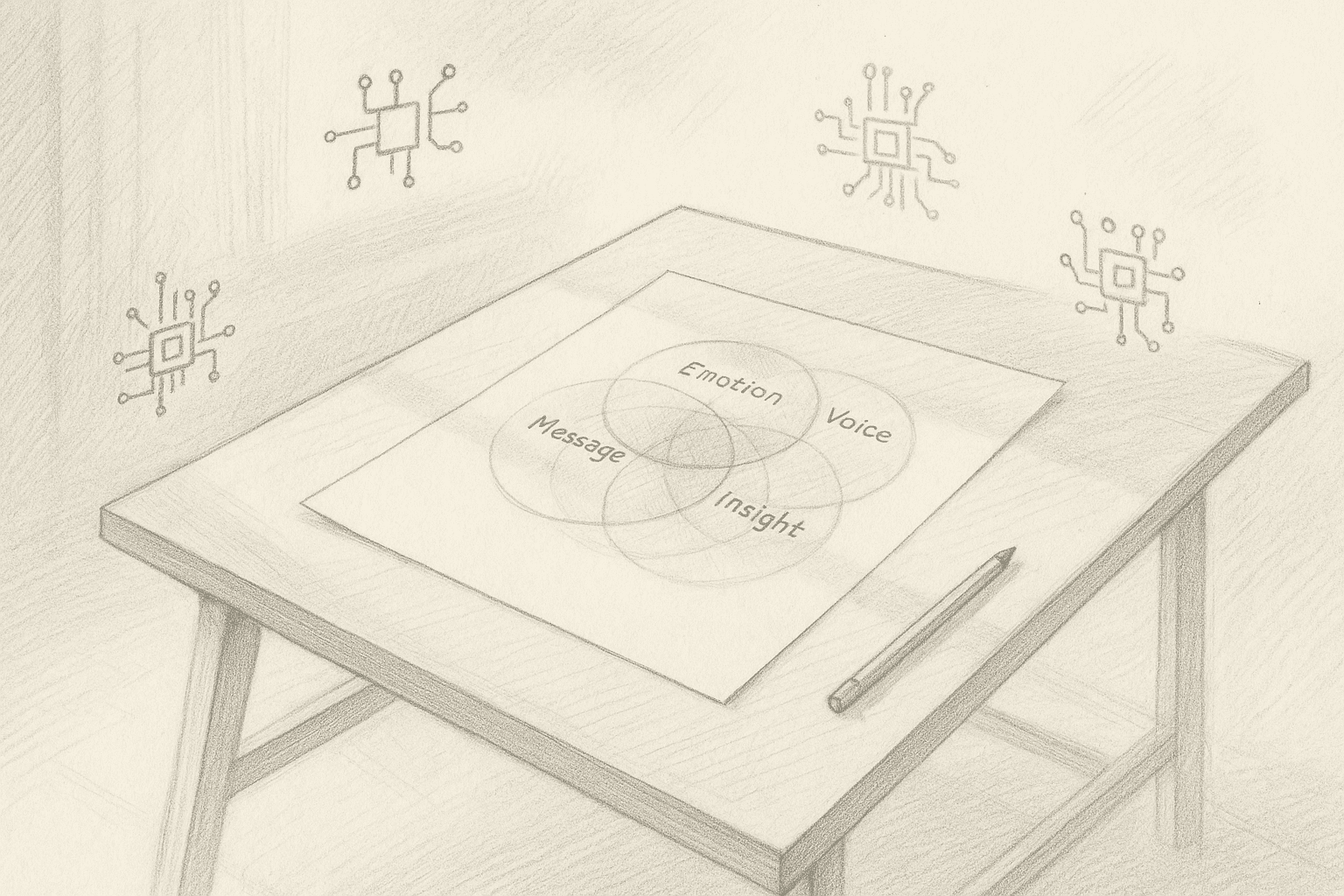The best brand deck I ever created fits in a text file.
No design flourishes. No gradient backgrounds. No carefully kerned typography. Just words, arranged simply, teaching an AI exactly what a brand stands for.
This shift from a visual approach to knowledge-based approach represents more than a format change. I believe it’s the difference between brands that will thrive with AI and those that will watch competitors pull ahead. An AI-amplified brand strategist is someone who understands this shift and acts accordingly.
What Is an AI-Amplified Brand Strategist?
An AI-amplified brand strategist bridges human insight with machine precision. By thinking like a prompt engineer, they ensure your brand voice is clear, consistent, and scalable across AI tools.
The Death of the 60-Slide Deck

For years, I lived by a simple rule: If a brand strategy couldn’t fit on one slide, it was too complex. Clear thinking demands relentless editing. But human-AI collaboration has pushed me further. Now, any brand I work with must be distillable into a single text document. A knowledge file so clean and precise that an AI can’t misinterpret it.
This constraint has been liberating. Strip away the design, the mood boards, the pages of examples, and what remains? The essential truth of what you’re building.
The Five Elements of an AI-Ready Brand File
A proper brand knowledge file for AI-amplified brand strategy contains five core elements:
- Mission, Vision, and Values (the real words, really simply)
- Brand Guidelines (voice, personality, principles)
- Messaging and Tone (with specific language patterns and examples)
- Customer Understanding (who they are, what they need, how they speak)
- Product Overview (what you make and why it matters)
Each section connects with absolute clarity. No contradictions. No corporate jargon. No “we’re innovative but also traditional.” Every word earns its place when you’re doing prompt engineering in branding (or context engineering if you agree with Andrej Karpathy).
Why Prompt Engineers Are the Future of Brand Strategy
The skills that make someone exceptional at brand strategy translate directly to AI collaboration. Distilling complexity, finding patterns, understanding the customer voice: these capabilities matter even more in the age of AI.
The mindset shift is critical. Traditional brand strategists craft; prompt engineers architect. The goal is to build systematic frameworks that scale human creativity. The real magic of an AI-amplified brand strategist happens in the space between human insight and machine capability.
A prompt engineer who understands brand strategy can transform qualitative research into structured knowledge. They can create AI tools that maintain brand consistency across thousands of touchpoints. They can build systems that amplify creativity. They turn customer insights into actionable AI training data. This is why hiring a prompt engineer makes strategic sense for modern brands.
Clean Data + Real Customer Voice: The Hidden Levers
Here’s what you need to know about AI for brand strategy: The magic is all about the preparation.
What do I mean by that? There are two foundations that make everything else possible for the AI-amplified brand strategist.
Ruthlessly Clean Data
Every inconsistency in your brand documentation becomes an AI hallucination. That aspirational tagline that conflicts with your actual customer experience? Your AI will find it and amplify the contradiction. The version 3.2 mission statement buried in a folder somewhere? It will surface when you least expect it.
Actual Customer Voice
Real customer language matters in human-AI collaboration. Call transcripts. Survey responses with all their detailed comments. Interview recordings where they struggle to articulate what they need. This raw material teaches AI to speak with authentic understanding of your customers. Without it, you get corporate wish lists instead of genuine connection.
Iteration: The Discipline of Clarity
The process of creating AI-ready brand architecture through prompt engineering in branding is humbling. You think you understand your brand until you try to teach it to a machine. Suddenly, every ambiguity shines brightly through.
I’ve developed a practice and approach of continuous refinement through Augmented Branding. Write the brand guidelines. Test them with AI. Watch where it stumbles. Clarify. Test again. Each iteration reveals hidden assumptions and unconscious contradictions. It’s an incredible way to pressure test your brand strategy without the human tendency to rationalize. This is what I see as the daily work of an AI-amplified brand strategist.
This cycling between human insight and AI interpretation is a form of quality control. It’s also interestingly a type of archaeological work, excavating the true brand from layers of complexity.
How AI Helps Us Avoid the Human Trap

Brands fail for many reasons, but one of the most surprising is boredom. Human creators chase novelty. We see the same messaging every day and think it needs refreshing. We mistake our own fatigue for brand necessity.
A well-trained AI doesn’t get bored. It doesn’t wake up Monday morning thinking the brand needs a revolution. When properly architected by someone skilled in AI for brand strategy, it maintains consistency with infinite patience while humans provide the spark of boundary-pushing creativity when genuinely needed.
Don’t get me wrong, this isn’t about rigid adherence to rules. Rather, I believe it’s about knowing the difference between strategic evolution and creative wandering. Ideally, the AI-amplified brand strategist understands this balance.
How to Build an AI-Amplified Brand Team
For brand managers considering their next hire, the question isn’t whether to bring in AI expertise. It’s how to find someone who bridges both worlds.
When you’re ready to hire a prompt engineer for your brand team, look for these qualities:
- Simplification instinct: They should be allergic to unnecessary complexity
- Technical curiosity: Comfort with systematic thinking matters more than coding skills
- Customer empathy: They want to translate human needs into structured insights
- Patience for iteration: Excellence comes from refining, not first drafts
- Strategic restraint: They know when not to use AI as much as when to use it
The best prompt engineers for brand strategy aren’t trying to automate creativity. They’re helping amplify human creativity through human-AI collaboration.
The Competitive Reality
Right now, your competitors might be taking one of two paths. Some dismiss AI as hype. Others are replacing human creativity with generic output and slop. Both approaches miss the real opportunity.
The brands that will dominate the next decade are building something different: AI systems trained on deep customer understanding, guided by clear strategic thinking, and deployed with human wisdom. They’ve hired prompt engineers who understand brand strategy at its core, and they are using new tools and approaches as the space continues to evolve.
They will dominate because they’re eliminating the friction between insight and execution. Their AI doesn’t guess what the brand would say or convince itself what it should say. It knows the boundaries. This is the potential of prompt engineering in branding.
How to Start Building AI-Ready Brand Architecture
You don’t need to hire a prompt engineer tomorrow (though it wouldn’t hurt). You can begin by auditing your own brand architecture:
- Take your brand guidelines and strip away all design. What remains?
- Read your mission, vision, and values aloud. Do they sound like clear beliefs or jargon?
- Gather actual customer language from emails, reviews, and call transcripts. How different is it from your messaging?
- Try explaining your brand to a basic AI tool. Where does it get confused?
- Identify every place two brand documents contradict each other. Choose one.
This preparation work matters whether you use AI or not, honestly. Because clarity is strategy, and precision is power.
The Revolution in Plain Text
The future of brand strategy isn’t in prettier decks or cleverer campaigns. It’s in the unsexy work of structured thinking and systematic creativity.
The AI-amplified brand strategist creates the conditions where both human and machine intelligence can flourish in relationship to one another. AI handles the repetitive so humans can focus on the “what ifs”.
This is exactly why your next brand strategist should think like a prompt engineer. The discipline of teaching machines reveals the clarity we should have had all along. It’s why hiring a prompt engineer is about finding someone who can architect brand truth.
The brands that win won’t be the ones with the best AI. They’ll be the ones whose human creativity is most skillfully amplified through strategic prompt engineering in branding. Their truth will be so clear that even a machine can speak it.
Your brand’s next chapter doesn’t need another pretty deck. It just needs a better text file. And it definitely needs an AI-amplified brand strategist to write it.
Amy is an AI-amplified brand strategist with over two decades of experience transforming complex brand architectures into clear, actionable frameworks. She pioneered the practice of converting traditional brand decks into AI-ready knowledge files, helping organizations achieve unprecedented consistency across digital touchpoints. Known for her “one-slide rule” approach to strategy, Amy now teaches brands how to architect truth so precisely that even machines can speak it authentically. Her work bridges the gap between human creativity and AI capability, driven by the belief that clarity is the ultimate competitive advantage in an AI-powered world.
Common Questions About AI and Brand Strategy
An AI-amplified brand strategist transforms brand complexity into precise knowledge architecture that AI systems can interpret and execute flawlessly, creating systematic frameworks that scale human creativity across thousands of touchpoints.
Prompt engineers bridge human insight and machine capability, building brand systems that eliminate friction between strategy and execution while ensuring every AI output reflects deep customer understanding and authentic brand voice.
AI maintains brand integrity with infinite patience, never deviating from core messaging due to boredom or novelty-seeking, while humans focus on strategic evolution and breakthrough creative work.
AI-ready documentation strips away design flourishes to reveal essential truth: five interlocking elements (mission/vision/values, guidelines, messaging, customer understanding, product overview) written with such clarity that contradictions become impossible.
No. AI amplifies human creativity by handling repetitive execution with perfect consistency, freeing strategists to focus on revolutionary thinking, customer insights, and the strategic evolution that keeps brands relevant.
